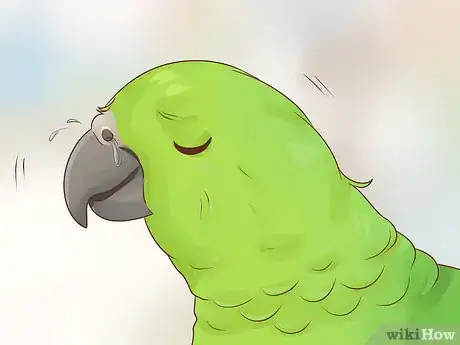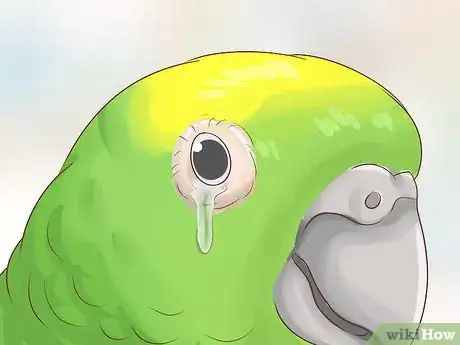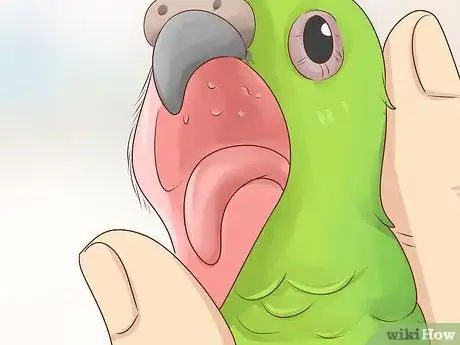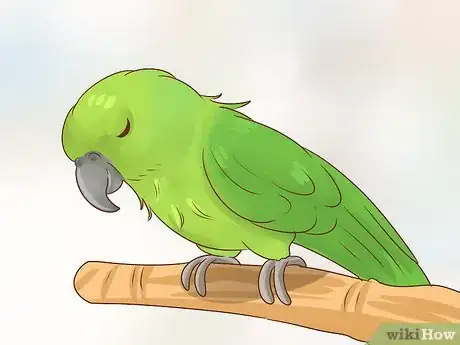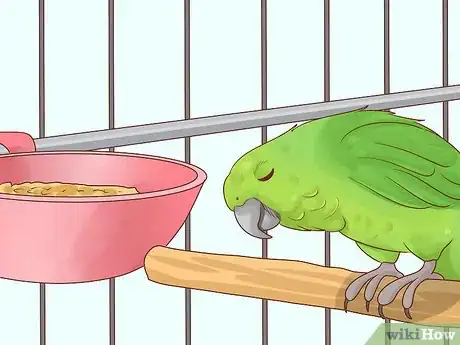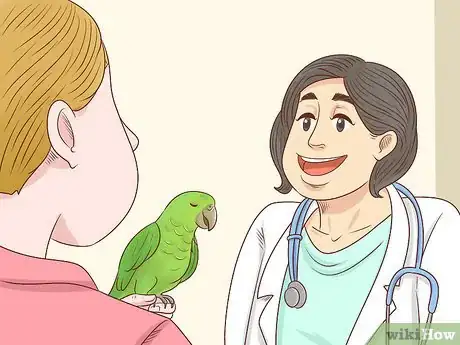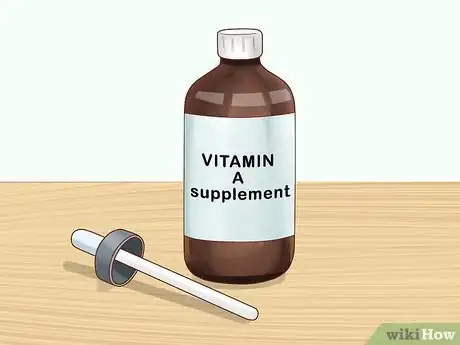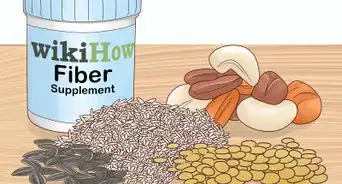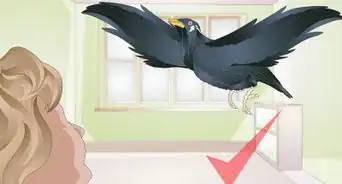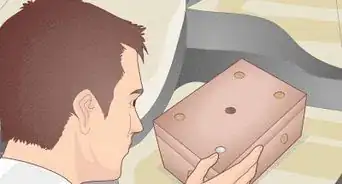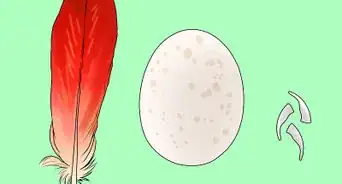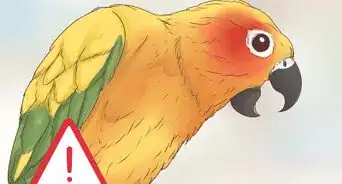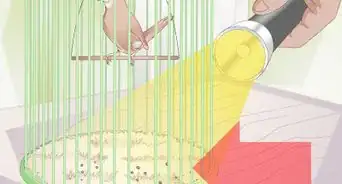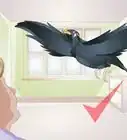This article was co-authored by Melissa Nelson, DVM, PhD. Dr. Nelson is a Veterinarian who specializes in Companion and Large Animal Medicine in Minnesota, where she has over 18 years of experience as a veterinarian in a rural clinic. She received her Doctor of Veterinary Medicine from the University of Minnesota in 1998.
There are 8 references cited in this article, which can be found at the bottom of the page.
This article has been viewed 17,256 times.
Vitamin A deficiency can be a major problem for Amazon parrots and other birds who are fed a diet comprised mostly of seeds. This kind of deficiency can lead to the deterioration of respiratory, digestive, and reproductive tissues and mucous membranes that leave the bird more susceptible to respiratory failure, bacteria, and other parasites – often even leading to death. To tell if your parrot has a vitamin A deficiency, watch for cold-like symptoms, weight loss, diarrhea, and white plaques inside the bird’s mouth. The best way to prevent this from happening to your Amazon parrot is to feed your bird a variety of fresh fruits and vegetables, especially those that are rich in vitamin A, on a daily basis.
Steps
Watching For Respiratory Symptoms
-
1Notice any cold-like symptoms. An Amazon parrot with vitamin A deficiency often appears as if it has a cold. It may seem lethargic, and it will probably have a plethora of respiratory symptoms that mimic the common cold.[1]
- This includes things like sneezing, wheezing, crusty nostrils, or runny nose/nasal discharge.
- It’s possible that these symptoms could also be caused by a bacterial infection of the upper respiratory tract. But this condition also needs to treated by a veterinarian.
-
2Monitor eyes that are swollen or have discharge. If you notice that your parrot’s eyes seem swollen or have any type of discharge being excreted, contact your veterinarian immediately. This is most likely a symptom of vitamin A deficiency.[2]
- There may also be white spots present around the bird’s eyes.
- While eye issues such as these could be indicative of other problems (like conjunctivitis or respiratory problems), you should still take your bird to the vet for a checkup.
Advertisement -
3Look for white spots inside the bird’s mouth. One of the biggest tell-tale signs of vitamin A deficiency can be observed by inspecting the parrot’s mouth. A vitamin A deficient parrot will have small white plaques (spots) on the roof of its mouth, or at the base of its tongue. These plaques eventually become infected, and cause large abscesses that can block the opening of the windpipe and cause labored breathing.[3]
- These symptoms are typically a red flag that your bird definitely has a vitamin A deficiency.
- The bird’s mouth may also seem slimy, or have very foul-smelling breath.
- Additionally, the bird may have trouble swallowing or refuse to eat.
Noticing Other Symptoms
-
1Be wary of depression or lethargy. Depression and lethargy are some of the biggest behavioral indicators that there is something wrong with your bird. If your Amazon parrot seems to have less energy or seems to sleep all the time, this may be a cause for concern – especially if these symptoms are paired with some of the other symptoms relating to vitamin A deficiency.[4]
- You should also monitor your bird’s behavior to see if it refuses to fly, seems to play with its toys less than usual, or prefers to stay inside its cage rather than interacting with its owners.
-
2Watch for diarrhea. Vitamin A deficiency is a serious condition that can wreak havoc on a bird’s digestive track. Because of this, diarrhea is often a common side effect. Monitor your parrot’s droppings to see whether the “firm” portion of the excretion is present or not. If the droppings are all liquid, or the feces part seems more like pudding, then your bird has diarrhea.[5]
- Remember that part of a bird’s poop is always liquid – this is the “urine” part of their droppings. Diarrhea depends on the solidity of the “feces” part of the droppings.
-
3Notice any lack of appetite or weight loss. If your bird seems to be eating less, or has started suddenly losing weight, it may be affected by vitamin A deficiency. This is especially true if it is paired with other symptoms of this type of deficiency.[6]
- The bird may also start gagging more frequently, especially when trying to eat.
Treating Vitamin A Deficiency
-
1Consult your veterinarian. If you are worried that your Amazon parrot has a vitamin A deficiency, you should contact your veterinarian’s office (or an avian specialist) immediately. Make an appointment to bring your bird in for an examination.[7]
- Depending on the severity of your parrot’s deficiency, your veterinarian may decide to hospitalize the bird, use an incubator or nebulizer, or even feed the bird through a tube and give it injections.
-
2Give your bird a vitamin A supplement. In order to regulate your parrot’s vitamin A deficiency, you may want to consider giving it a supplement. You should be able to purchase vitamin A supplements for birds at your local pet store. Simply add a few drops of the vitamin A to the bird’s food. You may need to puncture a capsule to access the supplement.[8]
- There is also a powder form of the supplement that you can sprinkle on top of the bird’s food.
- Only use a vitamin A supplement under the direction of your vet. You should always consult with your vet when providing supplements to your bird.
-
3Feed your bird plenty of fruits and veggies. Treating and preventing vitamin A deficiency depends largely on feeding your parrot fresh fruits and vegetables every day, especially those that have a high vitamin A content in the proper amounts. Typically, seed/pellet food should make up about 75% of your bird’s daily diet, while the remainder is comprised of fruits, vegetables, and nuts.[9]
- Fruits and vegetables that are particularly high in vitamin A content include carrots, broccoli, apricots, mango, papaya, nectarines, peaches, sweet potatoes, yellow squash, cantaloupe, spinach, red chili peppers, and turnip greens.
- Some fruits and vegetables that are particularly low in vitamin A content include apples, corn, bananas, lettuce, grapes, oranges, white potatoes, and summer squash.
References
- ↑ http://www.multiscope.com/hotspot/articles/vitamina.htm
- ↑ http://www.merckvetmanual.com/exotic-and-laboratory-animals/pet-birds/nutritional-diseases-of-pet-birds
- ↑ http://www.petmd.com/bird/conditions/digestive/c_bd_Vitamin_A_Deficiency
- ↑ http://www.vin.com/apputil/content/defaultadv1.aspx?pId=11147&id=3846188&print=1
- ↑ https://www.petcha.com/all-you-ever-wanted-to-know-about-bird-poop/
- ↑ http://www.peteducation.com/article.cfm?c=15+1835&aid=2054
- ↑ https://www.vetary.com/bird/condition/vitamin-a-deficiency-
- ↑ http://nilesanimalhospital.com/files/2012/05/Vitamin-A-Deficiency-in-Pet-Birds.pdf
- ↑ http://www.peteducation.com/article.cfm?c=15+1835&aid=2054
About This Article
To find out if your Amazon parrot has a vitamin A deficiency, look for cold-like symptoms, such as sneezing, wheezing, and nasal discharge. Also be on the lookout for swelling, discharge, or white spots around the eyes. Another common symptom to check for is small white spots on the roof of the mouth or at the base of the tongue, which may turn into sores or abscesses. Additionally, check to see if your bird has difficulty breathing or swallowing, a slimy mouth, or bad-smelling breath. For more tips from our Veterinarian co-author, including how to identify other symptoms of vitamin A deficiency in your parrot, read on!
